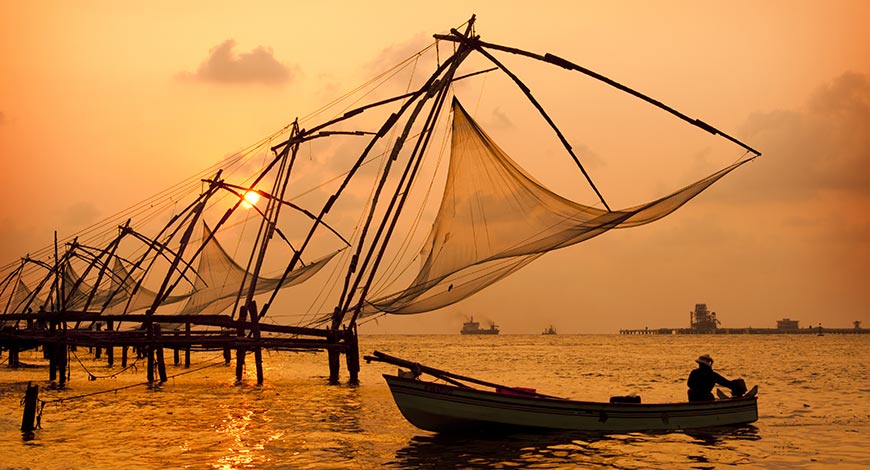As fish numbers decline in Chennai, how can we consume seafood sustainably
Fishing communities, restaurateurs, and researchers agree on the need for alternative ways to consume seafood to limit further stress on marine life. This is the concluding part of CarbonImpacts’s 2-part series on exploring solutions for sustainable food consumption patterns.
By Priyanka Thirumurthy / Jul 4, 2023

Image Courtesy: Businessworld
In October 2019, Chennai welcomed its first sustainable seafood restaurant ‘Sea Salt’, within the posh confines of Wallace Garden in Nungambakkam. This project was an experiment intent on changing how the city’s upper middle class and richer patrons consumed their seafood. Complete with a board announcing the catch of the day and a policy decision to serve only line-caught and locally-sourced fish, Sea Salt offered an alternative way to consume seafood that did not add further stress to marine life already suffering from the effects of overfishing, pollution and climate change.
“We took a month to visit fishing villages in Palaverkadu, Nachikuppam and along the shore to Puducherry to decide on how we will access the most fresh fish which is sustainably caught,” says Chef Harish Rao, who was a culinary consultant for Sea Salt. “We identified a few fishermen from Chennai’s fishing villages and decided to get the seafood from them directly. The conditions were that the fish must be in season and in its full size, must be line caught and should not be linked to trawler catch, the catch had to be from the same day and finally, alternatives were encouraged for species whose populations were dwindling,” he adds.
To the shock of many, Sea Salt did not offer Vanjaram (Seer fish) in its restaurant at all. A bold move considering that seer fish remains a favourite in Tamil cuisine given its meatiness, versatility and lack of bones. But a combination of reasons such as pollution, overfishing and climate change, which we have further explained in part 1 of the series, has affected its catch. The price of seer fish has gone up to even Rs.1500 per kilo over the last few years making it largely unaffordable for seafood lovers. To compare, in 2013, one kilo of the same fish cost merely Rs.150.
At Sea Salt, Indian salmon, Emperor fish, Barracuda and parrot fish based on their seasonal availability were intentionally used as substitutes for Vanjaram. In addition to this, members of the fishing community were brought in to explain to customers about how and where the seafood they were consuming was caught and the best way that it could be prepared.
To emphasize their commitment to sustainable seafood, the restaurant even held a three day festival in collaboration with the local fishing community from Ennore and Pulicat and made delicacies based on age-old recipes with dark mud crabs and shrimps caught exclusively in the Pulicat lake.
Sea Salt shut down in 2020 after a lockdown was announced to tackle COVID-19 but Sea Salt remains an excellent case study of the direction that we need to move in terms of consumption to keep seafood as a sustainable option in times of global warming. In part one of this series, we focussed on the adverse impacts of marine life due to increasing global warming, in part two we explore solutions for sustainable food consumption patterns to deal with declining marine food stock.
INTENTIONAL ADAPTATION
InSeason Fish, a seafood guide and consultancy, was the brain behind Sea Salt’s sustainability efforts. The collective had worked along with chef Harish Rao and are currently helping restaurants across the country to ensure that consumers ‘eat seafood right’.
“Fishermen are catching 100 edible species, but only 15-20 varieties are even consumed by customers,” says Divya Karnad, the co-founder of InSeason Fish and an Assistant professor of environmental studies in Ashoka University.
Dr Vivekanandan, former principal scientist at the Central Marine Fisheries and Research Institute (CMFRI) explains that if changes are not made to the current manner of procurement and consumption, a large section of consumers would be receiving only low quality fish in the future.
“Reducing fish catch is a problem of food security. We need to have access to fish which are free of contamination and in the right quantities to feed populations dependent on seafood,” says Dr Vivekanandan. “But as oceans get warmer, fishermen have to go deeper to find certain marine species and this in turn makes storage a challenge. This also makes the quality questionable,” he adds.
The fishing community, restaurateurs, researchers and scientists largely agree that four important steps have to be taken through the seafood supply chain to increase its sustainability - 1. Sourcing seafood from sustainable suppliers, 2. Not discriminating species, 3. Educating customers about their choices, 4.Relying on environment friendly aquaculture.
Dr Vivekanandan adds that, “Unlike high value fish like seer fish, low value fish or trash fish like sardines have more resilience to climate change. High value fish are large and predatory and may not be able to keep adapting to increasing temperatures. Ultimately only low value fish will enter the market and this will eventually change the consumption patterns.”
SOURCING SEAFOOD LOCALLY
Small scale fishers are considered to be ecologically more sensitive as they use equipment that is far less damaging to several species inhabiting the Bay of Bengal which swaddles the city of Chennai.
“Small fishermen use fiber boats and are aware of how to fish without hurting the local ecosystem,” says K Saravanan of, the treasurer of the Urur Koopam (a fishing hamlet in Chennai’s Besant Nagar) Fishermen Cooperative Society. “They ensure young fish are not dragged out of the sea before reaching maturity and they even put them back if they are caught on the net. If a shark or dolphin is caught they understand that they can’t bring it to shore and help it escape the net. They have a relationship with the sea,” he insists.
The fisherfolks’ representatives and even previous reports on the subject alleged that larger procurers tend to send mechanised boats and trawlers into the ocean which unsparingly catch everything within its vicinity, paying no heed to the season or the maturity of the fish.
Reaffirming the benefit of moving towards small scale fisheries, a paper titled ‘Small-scale fisheries and local food systems: Transformations, threats and opportunities’ states that, ‘Small-scale fisheries are also often able to react to the availability of particular fish, often due to the seasonality or abundance of certain species. This is an important aspect of small-scale fisheries in that they can adjust their fishing approaches and target fish based on seasonality, local abundance and local demands, employing a wide range of fishing gears.‘
At Sea Salt for example, two members of the fishing community were under permanent employ of the restaurant and after giving the morning supply of seafood that would be prepared for lunch, the employees would return to educate consumers during the dinner shift on what they were eating and how the sustainability aspect played into it.
Importantly, traditional knowledge of the fishing community also helped understand what the right alternatives could be for certain dishes, in order to avoid the over-dependency on a few species.
FORCED TO SEEK ALTERNATIVES
For Chennai’s hotel industry, this inevitability is already reshaping the menu cards.
"You no longer get prawns from September to January in the quantities we are used to. So we supply cultured prawns grown in farms to bigger hotels," says Vijay Kumar, a seafood supplier based in Chennai. "Instead of seer fish, we offer Panni Kola (a type of Grouper fish), which is a more affordable variety and we also have cultured sea bass because we no longer get the natural ones in our seas," he adds.
Multiple chefs and procurement managers from star hotels in Chennai confirm that even when cost is not an issue, variety, quality and size remain a challenge. "In the past 10 years, most hotels have transitioned to Individually Quick Frozen (IQF) prawns. Procurement of fresh sea prawns has been very difficult especially in terms of the sizes we need," says D Shankar, who handles procurement of seafood for The Park in Chennai. Vijay Kumar, who supplies to the hotel, points out that tiger prawns, karikadi and rani (Both a variety of prawns) that hotels prefer are not available, forcing them to switch to frozen alternatives.
But unlike prawns, for which an alternative was readily available, other seafood has been harder to replace.
Chef Mohana Krishnan, from the Savera Hotel in Chennai, says that a decade ago, there was no dearth of Vanjaram in the seas surrounding Tamil Nadu. But as the catch dwindled, the prices rose and economics did not add up.
"As catch reduces, fishermen stay out longer and so do the fish. So while we can say it is the catch of the day, it won't be the fresh catch of the day," says the chef. "Frozen fish is dominating the market because of this," he explains.
At the Park, chef Ashutosh has had to experiment with several fish before arriving at what he believes is a winner and uses Sea bass for ‘European grilled fish’ instead of seer fish.
"For European Grilled fish we started using black sea bass a year ago. The sea bass has a nice white colour to it and is flaky when cut open. So it is the perfect fish to be served whole," explains chef Ashutosh. "It also works out to be less expensive than seer fish," he adds.
But certain fish missing from the ecosystem could also mean the entry of other species.
"Until the mid-1980s, there were almost no oil sardines along the Tamil Nadu coast. Today the annual average catch in Tamil Nadu for this fish has increased by 100%. Oil sardines are now present along the West Bengal and Odisha coasts where they were never seen before this," explains Dr Vivekanandan. "Inversely, Kerala, where these fish were available in abundance, has seen a steep reduction in overall catch of oil sardines. In 2022, they only caught about 3,000 tonnes," he adds.
This figure is 98% lower than the annual average of sardine availability which stood at 1.66 lakh tonnes during 1995 to 2020, according to CMFRI.
In response to this, hotels in Chennai are seeing more customers opting to try oil sardines and add them to their menus. When this reporter visited The Marina, a seafood restaurant in Chennai in September, the Mathi Meen as it is called in Kerala was completely sold out. Sayed Altaf, a business development manager at The Marina said. “A lot of people are coming in and asking for the oil sardines now, in comparison to before. They have understood that it is rich in Omega 3 fatty acids and want to eat it for nutritional benefits,”
Meanwhile at Sea Salt, Chef Harish has learnt how to substitute mackerel instead of a vulnerable species like shark to make sura puttu (steamed shark cakes), from local fisherwomen.
But irrespective of the fish being substituted, Divya Karnad from InSeason points out that the problem is that it cannot be provided year round as it adds pressure on just one species, invariably leading to a decline in its population.
EDUCATING CUSTOMERS ABOUT THEIR CHOICE
For Chennai, InSeason Fish provides an online seasonal calendar of fish where customers can check the availability by month from the West or East Coast. By following this calendar, fish which are in their breeding season can be avoided. In February for instance, it is safe to eat Devi's anchovy, squid and lizard fish. They tell you to avoid Grey sharpnose sharks, yellowfin tuna and ribbon fish which will be breeding.
Dhruv points out that customers need to be educated about their choices in terms of nutrition and sustainability.
“Fish like mackerel and sardine are actually healthier than the larger species. The grouper species which is quite bony is very good for health and so is the Croaker fish. Restaurants and chefs can work with local coastal communities to understand the best ways to prepare these fish and general awareness must be spread to consumers who prefer cooking at home,” he adds.
In addition to education on alternatives, technology to trace the source of fish being consumed needs to be developed further in India. Traceability refers to the tacking of the product through its production and full life cycle. In the case of fish, it will mean tracking the full chain from sea to table.
AQUACULTURE DILEMMA
Adopting Aquaculture to tackle the growing effects of climate change on the availability of seafood and to improve its sustainability is a widely discussed solution.
Several research papers have hailed aquaculture as an option to cope with the world food demand. Studies have found that it has increased the access that poorer sections of society have to seafood. A study conducted by the United Nations shows that it can positively contribute to food security and nutrition and that if done correctly it boosts economic growth in coastal areas and helps keep waterways clean. It also provides employment opportunities for both men and women from coastal communities.
“Aquaculture can definitely supplement fish availability. Aquaculture of inland and freshwater fish like carp and hilsa (Tenualosa Ilisha) is being done very successfully,” says Dr.Vivekanandan. “Tilapia, a fresh water fish and even sea bass and Pompano are being cultured as well to good effect. But when it comes to aquaculture, fishes that are herbivores are more remunerative than carnivorous fish because meeting the nutritional needs for the latter becomes economically unfeasible after a point,” he points out.
CMFRI itself has been a huge promoter of cage aquaculture and has farms set up along Tamil Nadu’s coast. Environmentalists however fear that aquaculture could interfere negatively with the ecosystem of water bodies.
For instance, unused feed, antibiotic residue and fecal matter from aquaculture cages can pollute natural habitats of marine species and could become responsible for spread of diseases to other species.
However, community based aquaculture (CBA) could be a solution to this.
A research paper titled ‘Community based aquaculture in the Western Indian Ocean’ noted that community based approaches were very different from large scale enterprises. Small scale marine farming, the study stated, worked towards diversifying coastal livelihoods as well as promoting biodiversity and conservation. The study found positive ecological impact because CBAs worked towards increased biodiversity and biomass, habitat improvement, and stock enhancement, resulting from creation of reserves, no take zones, and marine protected areas as source of seed for finfish and shellfish to be used for aquaculture.
“As far as Chennai is concerned, there have been attempts to grow more salt water fish like Kaala and Bhekti to make up for depleting resources. But if we do not adopt a more sustainable manner of consuming seafood, we will be staring at a bleak future,” says Dhruv.
Within the supply chain, too, fishermen and suppliers believe a massive change is coming.
Chef N Kannan, a veteran in the industry, has worked with star hotels in Tamil Nadu for 25 years. He is not convinced by the taste of seafood that is cultured.
"Sea prawns are saltier and more flavourful. The IQF prawns, however, tend to be sweeter and have to be seasoned accordingly," he tells us. "Also while grilling them, they cannot be cooked as long as the sea prawns as the meat becomes very tough," he adds.
“If this continues, we will soon be eating only cultured fish that are grown in farms, not our seas,” says Vijay Kumar. “These would be lacking in taste and the nutrients we actually need and depend on from fish. That is the future I see.”
Also Read Part 1: Rising ocean temperatures impact fish catch and physiology in Chennai
Climate ChangeMarine heatwave Fishing Industry in Tamil Nadu Sustainable Fishing Methods

